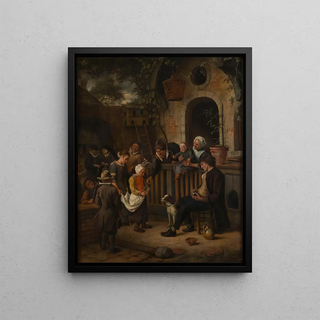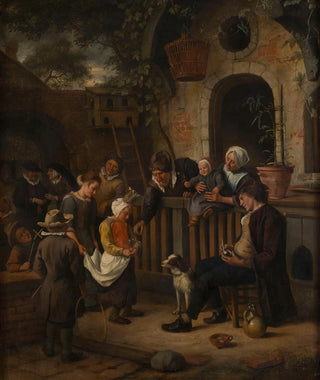Art print | Le petit auteur - Jan Steen


View from behind

Frame (optional)
In the vibrant world of 17th-century Dutch art, the art print "Le petit auteur" by Jan Steen stands out for its charm and depth. This painting, a true window into the daily life of the period, invites us to delve into the intimacy of a young aspiring writer. With a gaze sparkling with innocence and curiosity, the child, seated at a table, seems to capture the essence of creativity. The scene takes place in a warm interior, where every detail, from books to everyday objects, tells a story. The composition, both simple and rich in meaning, transports us to a suspended moment, where a child's imagination comes to life. Steen's work, through its authenticity, still resonates today, reminding us of the importance of art and writing in shaping our world.
Style and uniqueness of the work
"Le petit auteur" is characterized by a baroque style typical of Jan Steen, where light and color intertwine to create a lively and dynamic atmosphere. The artist, known for his ability to capture moments of daily life, excels here in the art of visual storytelling. The expressions of the characters, the play of light, and the meticulous details of the objects in the scene contribute to full immersion. The color palette, both soft and vibrant, evokes a sense of warmth and familiarity. Every element of the painting seems carefully chosen, allowing the viewer to linger on the nuances of the scene. The juxtaposition between the innocence of the child and the richness of the surrounding elements highlights the duality of life, between dream and reality—a recurring theme in Steen's work.
The artist and his influence
Jan Steen, born in Leiden in 1626, is often considered one of the masters of genre painting. His prolific career was marked by an exploration of themes of daily life, pleasures, and the vices of society of his time. Steen knew how to capture the essence of human nature with such finesse that he influenced many artists who followed. His ability to blend humor and melancholy, through scenes of everyday life

Matte finish

View from behind

Frame (optional)
In the vibrant world of 17th-century Dutch art, the art print "Le petit auteur" by Jan Steen stands out for its charm and depth. This painting, a true window into the daily life of the period, invites us to delve into the intimacy of a young aspiring writer. With a gaze sparkling with innocence and curiosity, the child, seated at a table, seems to capture the essence of creativity. The scene takes place in a warm interior, where every detail, from books to everyday objects, tells a story. The composition, both simple and rich in meaning, transports us to a suspended moment, where a child's imagination comes to life. Steen's work, through its authenticity, still resonates today, reminding us of the importance of art and writing in shaping our world.
Style and uniqueness of the work
"Le petit auteur" is characterized by a baroque style typical of Jan Steen, where light and color intertwine to create a lively and dynamic atmosphere. The artist, known for his ability to capture moments of daily life, excels here in the art of visual storytelling. The expressions of the characters, the play of light, and the meticulous details of the objects in the scene contribute to full immersion. The color palette, both soft and vibrant, evokes a sense of warmth and familiarity. Every element of the painting seems carefully chosen, allowing the viewer to linger on the nuances of the scene. The juxtaposition between the innocence of the child and the richness of the surrounding elements highlights the duality of life, between dream and reality—a recurring theme in Steen's work.
The artist and his influence
Jan Steen, born in Leiden in 1626, is often considered one of the masters of genre painting. His prolific career was marked by an exploration of themes of daily life, pleasures, and the vices of society of his time. Steen knew how to capture the essence of human nature with such finesse that he influenced many artists who followed. His ability to blend humor and melancholy, through scenes of everyday life






